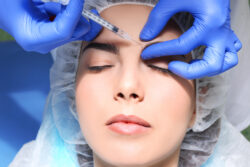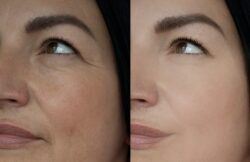
What Is A Brow Lift – A Complete Guide
A brow lift, also called a forehead lift, is a popular procedure that helps give your face a younger, more refreshed appearance. It lifts the eyebrows and smooths out forehead wrinkles, helping you look more awake and rejuvenated. If you’re dealing with sagging brows or deep forehead lines, a brow lift can bring balance back to your face.
Before you decide to go ahead with the procedure, it’s helpful to understand what it entails. Knowing what to expect, the benefits and the recovery time will make you feel more confident in your choice and help you achieve the best results.
What is a Brow Lift?
A brow lift is a procedure that lifts your eyebrows and smooths out the skin on your forehead, giving your face a more refreshed and youthful look. As we get older, factors like gravity and sun exposure can cause the skin around your eyes and forehead to sag, making you look tired or even frustrated. A brow lift can fix this by lifting the brows and smoothing out wrinkles, helping you look more awake and energized.

Types of Brow Lifts and What They Do
There are a few different types of brow lifts, and the right one for you depends on your goals and how much lifting you need:
- Traditional Brow Lift: This is the most common option. It involves a single long incision across the forehead, just behind the hairline. The surgeon lifts the skin and tissue to smooth out the forehead and reposition the brows.
- Endoscopic Brow Lift: Instead of one long incision, this method uses a few small cuts hidden in the hairline. A tiny camera is used to help the surgeon lift the brows and smooth wrinkles, leaving less scarring and allowing for a quicker recovery.
- Temporal Brow Lift: This focuses on lifting the outer part of the brows. It’s often chosen by people who have sagging on the sides of their forehead. The incisions are smaller and placed along the hairline at the temples, so it’s less invasive than other types.
- Coronal Brow Lift: This involves a long incision that runs from ear to ear across the top of the scalp. It’s a more invasive option but gives more dramatic results, especially for people with more noticeable sagging or deep forehead wrinkles.
- Hairline Brow Lift: If you have a high forehead or a receding hairline, this lift uses an incision along the hairline to lift the brows. It helps reduce the height of the forehead while also addressing sagging, which is ideal for improving both your brow position and hairline.
- Limited Incision Brow Lift: Also called a “mini brow lift,” this method uses smaller incisions than a traditional brow lift. It’s less invasive and is great for people with less severe sagging who want more subtle results.
Your surgeon will help you choose the best option based on your needs and what kind of results you’re hoping for.
Benefits of a Brow Lift
A brow lift can have a big impact on how you look and feel. Here’s how it can make a difference:
A More Youthful Look
As we get older, the skin on our forehead and around our eyes can start to sag, causing wrinkles and a tired appearance. A brow lift smooths out those wrinkles and lifts the brows, helping you look fresher and more awake. It can take years off your face, giving you a rejuvenated, youthful appearance.
A Boost in Confidence
When you feel good about your look, it can really boost your self-esteem. A brow lift can make you look more energized and approachable, which can positively affect how you feel about yourself. Many people find that this simple procedure helps them feel better in their own skin and more confident, whether in social settings or at work.
Improved Facial Balance
A brow lift doesn’t just lift the brows; it can also create a more balanced look across your face. Lifting the eyebrows to a youthful position helps balance your upper face, eyes, and forehead. This makes your eyes appear larger and more open, giving you a more harmonious look. Plus, it can smooth out forehead lines and improve the shape of your brow bone, helping your face look more proportionate.
Who Is a Good Candidate for a Brow Lift?
A brow lift can be a great way to refresh your appearance, but it’s important to see if you’re the right fit for it. Here’s what to keep in mind:
Age and Skin Type
There’s no specific age for a brow lift, but most people who get one are between 40 and 60. Some people in their 30s might choose this procedure if they notice early signs of sagging or deep forehead lines. Your skin’s firmness is important too. If your skin still has some elasticity and tone, you’re likely a good candidate. If your skin has lost a lot of its firmness or shows significant sun damage, the results might not be as noticeable, and your doctor might suggest other options.
Ideal Candidates
The best candidates for a brow lift are those who have noticeable sagging in their brows or deep forehead wrinkles. If drooping brows make you look tired or angry, or if you feel self-conscious about forehead lines, a brow lift could help you feel more confident. It’s also a good choice if you want to restore a youthful, balanced look to your face.
Health Considerations
A brow lift is generally safe, but certain health conditions can affect whether you’re a good candidate. If you have serious health problems like uncontrolled high blood pressure, heart disease, or blood-clotting issues, your doctor may recommend avoiding surgery or taking extra precautions. Also, it’s important not to smoke, as smoking can slow down healing and increase risks.
Before deciding if a brow lift is right for you, it’s a good idea to consult with a qualified surgeon. They’ll look at your skin, face, and overall health to help you decide if it’s the best choice for your goals.

Brow Lift Procedure
If you’re thinking about a brow lift, here’s what you can expect during the process:
Step 1: Getting Ready
Before the surgery, you’ll have a consultation with your surgeon to talk about your goals and decide the best approach for your brow lift. On the day of the surgery, you’ll change into a gown and get ready for the procedure. Your surgeon will mark areas on your forehead and around your brows to guide the incisions and ensure the results are exactly what you’re looking for.
Step 2: Anesthesia
Most brow lifts are done with general anesthesia, so you’ll be fully asleep during the surgery. In some cases, the surgeon may use local anesthesia with sedation, which numbs the area and keeps you relaxed but awake. The choice of anesthesia depends on your health and the complexity of the procedure, and your surgeon will discuss the best option for you.
Step 3: Making the Incision
Once you’re asleep or relaxed, the surgeon will make the incisions needed for the brow lift. For a traditional brow lift, the incision is usually made across the top of the forehead, just behind the hairline. If you’re having an endoscopic lift, smaller incisions are made within the hairline, and a small camera is used to guide the surgery. After the incisions are made, the surgeon will lift the skin and underlying tissue to reposition the brows and smooth out any wrinkles.
Step 4: Positioning the Brows
The surgeon will move the brows to the desired position and remove any extra skin or tissue. The goal is to give you a refreshed, natural look that fits your facial features and enhances your overall appearance.
Step 5: Closing the Incisions
Once the brows are in place, the surgeon will carefully close the incisions using sutures. Depending on the technique used, the incisions may be hidden in your hairline or along natural lines of your skin to minimize visible scarring.
What to Expect During Surgery and Recovery
During the Surgery
The procedure usually lasts about 1 to 2 hours, depending on the type of brow lift you’re having. You’ll be completely asleep thanks to the anesthesia, and the medical team will keep a close eye on you to ensure everything goes as planned.
Recovery Time
Once the surgery is done, you’ll wake up in a recovery room. At first, you might feel a bit groggy or confused, but this should pass quickly. Most people go home the same day, but you’ll need someone to drive you. You can expect some swelling, bruising, or mild discomfort, but these things tend to improve after a few days.
Post-Surgery Care
Your surgeon will give you detailed instructions on how to care for your incisions, including how to keep them clean and manage swelling. For the first few weeks, you’ll need to avoid heavy physical activity and be gentle with your face while it heals. The stitches will be removed in about 7 to 10 days.
Full Recovery
It typically takes about 1 to 2 weeks for the initial recovery, but it may take several months before the final results are clear and any remaining swelling goes down. Most people can return to their usual routine within 1 to 2 weeks, although some may need a little longer.
Recovery and Aftercare
Recovering after a brow lift is a crucial part of achieving the best possible results. Here’s a simple guide to help you understand what to expect and how to take care of yourself during the healing process:
How Long Does Recovery Take?
Most people need about 1 to 2 weeks to recover after a brow lift. In the first few days, you might experience swelling, bruising, and some mild discomfort around your forehead and eyebrows. These symptoms are completely normal and should improve within a week. After 7 to 10 days, you’ll probably feel ready to get back to your normal routine, but it’s important to avoid any activities that might strain your face.
How to Care for Yourself After Surgery
Taking care of yourself after surgery is key to a smooth recovery. Here are some helpful tips:
- Sleep with your head elevated: For the first few days, prop your head up on pillows to reduce swelling.
- Use ice packs: Apply ice wrapped in a cloth to your forehead and eyes for the first 48 hours to help reduce swelling and bruising.
- Take prescribed medications: Your doctor might give you pain relievers or antibiotics. Be sure to follow the instructions closely.
- Avoid touching your face: Don’t touch, rub, or put pressure on your face, especially during the first week.
- Follow-up appointments: You’ll have a follow-up visit about 7 to 10 days after the surgery to check how you’re healing and remove any stitches.
- Protect your skin from the sun: Your skin will be more sensitive after surgery, so make sure to wear sunscreen when you’re outside, especially in the early days of recovery.
What Risks and Complications Should You Be Aware Of?
While brow lifts are generally safe, as with any surgery, there are some risks. It’s important to keep an eye out for these and contact your surgeon if you notice anything unusual:
- Infection: If you notice redness, warmth, or any discharge from the incision sites, it could be a sign of infection. Contact your surgeon right away if this happens.
- Scarring: Your surgeon will work to minimize scarring, but some people may still have visible scars. Over time, scars usually fade, and following the aftercare instructions can help them heal well.
- Numbness or tingling: It’s common to feel numb or have tingling around your forehead or eyebrows after the surgery, but this usually goes away in a few weeks.
- Asymmetry: Sometimes, the brows may not be perfectly even after surgery. If this worries you, talk to your surgeon. Minor adjustments can often be made.
- Hematoma or bleeding: Rarely, you may experience bleeding or swelling under the skin. If this happens, your surgeon will take care of it.
Results and Long-Term Care
After your brow lift, it’s natural to be eager to see the results. Here’s what to expect right after the surgery and in the long run:
What to Expect Right After Surgery
Immediately after your brow lift, you’ll notice a difference in the position of your eyebrows and the smoothness of your forehead. However, the full results might be a bit hidden by swelling and bruising. Your forehead and eyebrows might look a little tight or dramatic at first, but that’s completely normal as your skin adjusts. Over the next few days and weeks, the swelling will go down, and your face will start to look more balanced and youthful.
How Long the Results Last
The results of a brow lift can last anywhere from 5 to 10 years, depending on your age, skin type, and lifestyle. Even as you continue to age, your eyebrows will likely stay in a better position than they were before the surgery. If your skin has lower elasticity or you go through major changes in weight or health, the effects may not last as long.
How to Keep Your Results Looking Good
To help keep your brow lift results looking their best, it’s important to follow a solid skin care routine and live a healthy lifestyle. Here are some tips to help you out:
- Protect Your Skin from the Sun: Protecting your skin from UV rays is one of the best ways to keep your youthful look. Make sure to wear sunscreen, even on cloudy days, and consider wearing a wide-brimmed hat when outside.
- Moisturize Your Skin: Keep your skin hydrated to help it stay smooth and firm. Find a moisturizer that works for your skin type and use it daily.
- Maintain a Healthy Lifestyle: Eating a balanced diet, staying hydrated, and avoiding smoking all help keep your skin healthy. Smoking can speed up aging, so avoiding it will help your brow lift results last longer.
- Consider Touch-Ups: Over time, if you notice sagging or changes you’d like to address, touch-ups or treatments like Botox can help maintain your look.
- Get Plenty of Water and Rest: Staying hydrated and getting enough sleep are key to keeping your skin looking fresh and healthy.
Brow Lift Alternatives
If you’re thinking about refreshing your look but want to skip the surgery, there are a few non-surgical options that can give you results similar to those of a traditional brow lift. Here’s a look at some choices you might want to consider:
Botox
Botox is a popular treatment for smoothing forehead wrinkles and lifting the brows. It works by temporarily relaxing the muscles in your forehead, which helps your brows look smoother and more youthful. Many people refer to it as a “non-surgical brow lift” because it can lift the brows by relaxing the muscles that pull them down.
- How long it lasts: Botox usually lasts 3 to 6 months. While it gives the forehead and brow area a lifted, smoother look, it won’t be as dramatic as a full brow lift.
- Recovery: There’s no downtime with Botox, so you can go back to your usual activities right away. You might have mild swelling or bruising at the injection sites, but it will go away within a few hours or a couple of days.
Dermal Fillers
Dermal fillers are another non-surgical option for lifting the brow area. These fillers are injected around the brows and forehead to add volume and help lift sagging areas. This treatment can also smooth out wrinkles and bring back some of the volume that may have been lost over time.
- How long it lasts: Fillers last anywhere from 6 months to a year, depending on the type used. While they do give a lifted look, it’s not as dramatic as a full brow lift.
- Recovery: Like Botox, dermal fillers have minimal recovery time. You might experience some swelling or bruising, but it usually goes away within a few days.
Thread Lift
A thread lift is a minimally invasive option where temporary sutures are inserted under the skin to lift and tighten the skin around the brows and forehead. It’s a good option if you want a more noticeable lift than Botox or fillers but aren’t ready for surgery.
- How long it lasts: The results from a thread lift last about 1 to 3 years. It gives a more noticeable lift than Botox and fillers, but it’s not as long-lasting as a full brow lift.
- Recovery: Recovery is relatively short, with most people returning to normal activities within a few days. There might be some mild swelling, bruising, or discomfort, but it typically resolves quickly.
Comparing Effectiveness and Recovery Time
- Effectiveness: If you’re looking for the most dramatic, long-lasting results, a traditional brow lift is the best option. It’s ideal if you have significant sagging or wrinkles. Botox and dermal fillers are great if you have milder concerns or want something less invasive. Thread lifts are a good middle ground, offering more lift than Botox or fillers without the need for full surgery.
- Recovery Time: Botox and dermal fillers are the quickest to recover from. There’s no downtime, and only minor swelling or bruising that fades fast. Thread lifts require a bit more recovery, but it’s still less than surgery. A traditional brow lift takes the longest to heal, usually about 1 to 2 weeks, with swelling and bruising in the first few days.
The best choice for you will depend on your goals, how much downtime you’re okay with, and how dramatic you want the results to be. If you’re looking for a gentle lift with little recovery time, Botox or fillers might be the way to go. But if you want a more noticeable and long-lasting change, a traditional brow lift might be the right choice. Your surgeon or aesthetician can help guide you in finding the option that’s best for you.
How Much Does a Brow Lift Cost?
The cost of a brow lift can vary depending on a few things, such as the type of procedure, the surgeon’s experience, and where the surgery is done. Here’s a simple breakdown to help you understand what to expect:
Traditional Brow Lift – A traditional brow lift typically costs between $3,000 and $8,000. The price can depend on how complex the procedure is, how skilled the surgeon is, and where the surgery takes place. For example, the cost might be higher in big cities or areas with a higher cost of living.
Endoscopic Brow Lift – Endoscopic brow lifts use smaller cuts and a camera to help the surgeon. These are usually a little more affordable than traditional brow lifts, with prices ranging from $2,500 to $6,000. The procedure also tends to be quicker, which might help lower the cost.
Non-Surgical Options – If you’re looking at alternatives like Botox or dermal fillers, these tend to be much cheaper. Botox can cost between $200 and $1,200 per session, depending on how much you need. Dermal fillers are priced from $600 to $2,000 per syringe, depending on the type of filler and where it’s used.
What Affects the Cost?
- Surgeon’s Experience: More experienced surgeons might charge higher fees, but their expertise could lead to better results and fewer complications.
- Location: The location of the surgery plays a role. Brow lifts in larger cities or places with a higher cost of living tend to be more expensive.
- Facility Fees: If the surgery takes place in a hospital or surgical center, there may be extra facility fees that can add a few hundred or even thousands of dollars to the cost.
- Anesthesia: The type of anesthesia used can also affect the price. General anesthesia tends to be more expensive than local anesthesia.
- Post-Operative Care: Aftercare, including follow-up visits or any additional treatments, can also factor into the overall cost.
Is It Worth It?
A brow lift can be a significant investment, but many people find the results are well worth it. It can give you a more refreshed look, boost your confidence, and provide long-lasting changes. If you’re considering it, make sure to talk to a board-certified plastic surgeon who can give you a more personalized estimate based on your goals.

How to Choose a Qualified Surgeon
Choosing the right surgeon for your brow lift is a big decision, and it’s important to feel confident that you’re in good hands. You want someone with the right experience, skills, and understanding of your goals. Here’s a simple guide to help you find the right surgeon:
What to Look for in a Skilled Surgeon
Board Certification
First, check if your surgeon is board-certified by the American Board of Plastic Surgery (ABPS) or another trusted organization. This means they’ve gone through the necessary training and meet high standards for safety and skill.
Experience with Brow Lifts
Not all plastic surgeons specialize in brow lifts. Make sure you choose one who has experience specifically with this procedure. A surgeon who regularly performs brow lifts will be more familiar with the techniques needed to get the best results.
Before and After Photos
Ask to see before and after photos of their past brow lift patients. This gives you a good idea of their work and whether their results match what you’re hoping for. If they don’t have a portfolio to show, that could be a red flag.
Patient Reviews
Look up reviews from other patients. Positive feedback is a good sign that the surgeon is skilled and trustworthy. Check sites like Google, Yelp, or RealSelf to get a sense of what others think of their work.
Accredited Surgery Centers
Make sure the surgeon operates in an accredited surgery center or hospital. These places follow strict safety guidelines and provide high-quality care.
Questions to Ask During Your Consultation
Once you’ve found a surgeon you’re considering, schedule a consultation. This is your chance to ask questions and make sure you feel comfortable with them. Here are a few questions to consider:
How much experience do you have with brow lifts?
Ask how many brow lifts they perform each year and ask to see examples of their work. You should feel confident in their ability to deliver the results you want.
Am I a good candidate for a brow lift?
A skilled surgeon will evaluate your facial features and skin condition to determine if a brow lift is the right option for you. They should also explain if another procedure might be a better fit.
Which type of brow lift would be best for me?
There are different methods for brow lifts, such as traditional, endoscopic, or temporal. Ask the surgeon which one they recommend and why.
What are the risks and complications?
Every surgery carries some risk. Be sure to ask the surgeon about any potential risks and how they handle complications.
What’s the recovery process like?
It’s important to understand the recovery process before committing. Ask how long it will take to heal, any restrictions you’ll have, and when you can get back to your regular activities.
Can you show me before and after photos of your previous patients?
Look at results from people who have similar concerns, age, and skin type as you. This will give you a better idea of what to expect.
What’s included in the cost?
Make sure you understand the full cost of the procedure, including the surgeon’s fees, anesthesia, facility charges, and post-surgery care. Getting a clear breakdown will help avoid any surprises.
How do you ensure patient safety during surgery?
Ask the surgeon how they ensure your safety throughout the procedure, including what kind of anesthesia they use and how they handle any unexpected issues.
Brow Lift Before and After: What to Expect
Looking at before and after photos is one of the best ways to get an idea of the results you can expect from a brow lift. These images give you a clear picture of how the procedure can change your forehead, brows, and overall expression. Here’s a breakdown of what to expect before and after your brow lift:
Before the Brow Lift
Consultation and Planning
Before the surgery, you’ll meet with your surgeon to discuss your goals. They’ll assess your facial features, skin condition, and any concerns you have, such as sagging brows or forehead wrinkles. Based on this, they’ll create a personalized plan to get the best results for your unique face.
Pre-Surgery Instructions and What to Avoid
Your surgeon will give you instructions to prepare for the surgery, including what to avoid in the days leading up to the procedure. Some things you may need to avoid include:
- Certain medications: Your surgeon may recommend stopping medications like blood thinners, aspirin, or anti-inflammatory drugs to reduce the risk of bleeding.
- Smoking: Smoking can slow down the healing process, so it’s important to stop smoking for at least a few weeks before the surgery.
- Alcohol: Avoid drinking alcohol for at least a week before surgery, as it can increase the risk of bleeding and interfere with anesthesia.
- Fasting: You will likely be asked to fast the night before surgery to ensure your stomach is empty when you receive anesthesia.
These steps help you prepare for the surgery and ensure the procedure goes as smoothly as possible.
The Day of the Procedure
On the day of the surgery, you’ll receive anesthesia to keep you comfortable. Depending on the type of brow lift you’re getting (traditional or endoscopic), the surgeon will make small cuts in the right areas to lift and tighten the skin. You may feel some pressure, but you shouldn’t feel any pain.
After the Brow Lift
Immediately After Surgery
After the surgery, you’ll be monitored in a recovery area for a short time. You might experience swelling, bruising, and mild discomfort around your forehead and eyes, but these side effects are temporary and will improve over the next few days.
The First Few Weeks
Following your surgery, you’ll need to take it easy and follow your surgeon’s aftercare instructions. This typically involves resting, keeping your head elevated to reduce swelling, and avoiding heavy activity. Your surgeon may also suggest ointments or ice packs to help with the healing process.
Visible Results
After 1-2 weeks, most of the swelling and bruising will go down, and you’ll start to notice your brows lifted and your forehead smoother. While there might still be some mild swelling, you’ll see a more youthful look with improved symmetry.
Long-Term Results
In 3 to 6 months, the full results will become clear. Your brows will look more lifted, and your forehead wrinkles and frown lines will be greatly reduced. Many people enjoy these results for 10 years or longer, depending on skin elasticity and age.
Before and After Images

Brow Lift: What You Need to Know
A brow lift can be a great way to refresh your look and smooth out signs of aging, like sagging brows and forehead wrinkles. At Palm Beach Dermatologist, the procedure works by lifting and tightening the skin, helping balance your facial features and giving you a more youthful, rejuvenated appearance. Whether you’re considering a traditional brow lift, an endoscopic option, or a non-surgical alternative, it’s important to understand the procedure, recovery time, and expected results before making a decision.
Choosing the right surgeon is key to getting the best results. Take your time during consultations to ensure you feel comfortable and confident with your choice. Also, consider your personal goals, health, cost, and any ongoing care needed to keep your results looking fresh.
Ultimately, a brow lift at Palm Beach Dermatologist can boost your self-esteem and help you feel more confident in your appearance. If sagging brows or forehead wrinkles are affecting how you feel about yourself, a brow lift might be the perfect solution to restore your youthful glow.
FAQs
How long does a brow lift last?
A brow lift can last anywhere from 5 to 10 years, depending on things like your age, skin type, and lifestyle. While the results aren’t permanent, most people enjoy a noticeable improvement for a long time.
Is a brow lift painful?
Most people experience very little pain during the procedure because of the anesthesia. Afterward, you may feel some discomfort, but it’s usually manageable with over-the-counter pain relievers. Swelling and bruising are common, but they typically fade within a couple of weeks.
How long does it take to recover from a brow lift?
Recovery usually takes about 1 to 2 weeks. You’ll need to rest and avoid strenuous activities, but many people can get back to work after just a week. Full recovery, including the reduction of swelling, usually takes about 3 to 6 months.
Can I get a brow lift without surgery?
Yes, you can! Non-surgical treatments like Botox or dermal fillers can temporarily smooth out the forehead and brow area. These options heal quicker but offer more subtle results compared to a full brow lift.
Am I a good candidate for a brow lift?
If you have sagging brows, forehead wrinkles, or deep frown lines, you might be a good candidate for a brow lift. The best candidates are healthy, non-smokers, and have realistic expectations about the outcome.
Are there any risks with a brow lift?
Like any surgery, there are some risks, such as infection, scarring, or changes in sensation. However, these risks are minimal when the procedure is done by a skilled surgeon. Your surgeon will go over any potential risks during your consultation.
How do I choose the right surgeon for my brow lift?
Look for a board-certified plastic surgeon who has experience with brow lifts. Check out their before-and-after photos, read reviews from other patients, and ask about their approach. Don’t be afraid to ask questions to make sure you’re comfortable with their experience and skills.
Will a brow lift smooth out all the wrinkles on my forehead?
A brow lift can help smooth out many wrinkles and lift sagging brows, but it won’t make your forehead completely wrinkle-free. The goal is to give you a more youthful and natural look, not a perfectly smooth forehead.
Can a brow lift be combined with other procedures?
Yes, many people combine a brow lift with other treatments like eyelid surgery (blepharoplasty), facelifts, or dermal fillers for a more complete rejuvenation. Your surgeon can help you figure out which options are best for you.
Can a brow lift fix deep wrinkles between my eyes?
A brow lift can help with forehead wrinkles and sagging brows, but it might not completely smooth out deep frown lines between your eyes. For those lines, Botox or fillers might be more effective. Your surgeon can help you plan the best treatments for both areas.
